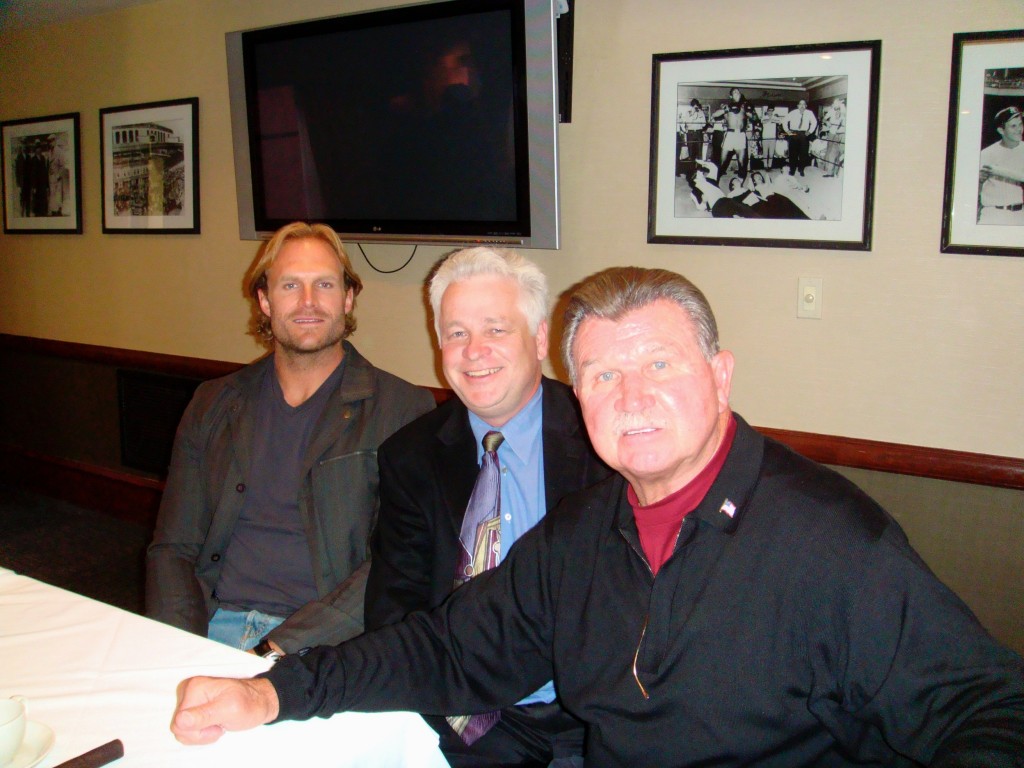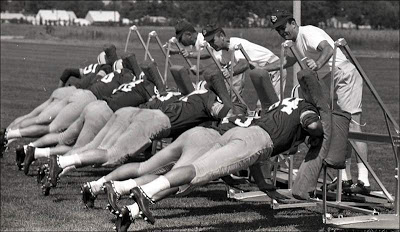Tony Romo suffered “micro-fractures” in his spine, his owner said his back injury was a “pain tolerance” issue. Various sports reporters have gone out of their way to say that it isn’t a fracture it is a “micro” fracture. This is why football players, when they retire or are forced out of the game by injury, have long lasting and devastating injuries. While the focus has been about concussions, and the NFL, the disability caused by orthopedic injuries in the game of football are far greater, and less talked about. Those injuries, as it turns out, stem a great deal from how the NFL players practice.
The “worn jerseys” for sale from NFL stores are popular, but not all jerseys and gear is sold- they don’t sell the ones with blood, they don’t sell the ones where the football player has been hit so hard their bowel evacuate. That happens a lot. These giant men, take hits- go back out, and get hit again.
I got to see these men after their careers were over. Some were destitute, having spent all their money on medical care for which no one would insure them for. But even those with the best medical care, continued to live in chronic pain – pain being a part of their lives so much that they would privately be asking me how to commit suicide (I got them to a suicide help line and some pain management). These were some of the football giants, men who “could take a hit” and did on the field of play, game after game. Now – it was worse. The newer players were affected far more than the older players – the game became faster, the men were larger, and the hits were harder.
Did you ever wonder why the average lifespan of a former NFL player is so short? I don’t. But all of this starts with the way these men practice- and the boys practice.
Modern football has to change the way it practices as the long term injuries lead to permanent disabilities. The “full pad” should not cause injury, but they do. Football teams that have smarter but not harder practices do well in the play-offs with less injured players.
At a Gridiron Great dinner Gale Sayers was talking about how in football practice he was taught that “you have to learn to take a hit.” This is what is commonly practiced in the NFL, college football, and high school football. Yet our dinner was to help benefit hundreds of former NFL players who were disabled as a result of chronic hits in football. Many former NFL players had made a lot of money in their career, and were mostly destitute because of medical bills. “Full pad practice” and “taking a hit” seems great for testosterone loving people, but every hit represents an injury, and every injury has to heal. When a joint or soft-tissue around a joint or a muscle heal, they never heal completely back to normal. Every injury has potential life long consequence to the individual.

Trying to help the Gridiron Greats – with Mike Ditka and Kyle Turley
There is no science to recommend “full pad practice.” In fact, every bit of science shows the opposite. But most football coaches practice in this arcane and dangerous manner, thinking it will make their athletes better than before. “The harder you practice the better prepared you are.” If you have ever seen an old athlete, like my friend, Hal Elmers – who played fullback for Lewis and Clark College in the late 1940’s – you will see people who have worn out joints, chronic pain, and immobile. Hal was fast, and in those days the opposition players might have tipped the scale at 200 pounds. Football players in the 1940’s didn’t hit hard, but they still tackled. Today, Hal is in a wheelchair- having had multiple orthopedic operations over his life because of football – and that was football as a gentler sport in the 1940’s.
Scar tissue is not as strong as bones and joints. A person does not get tougher by taking more hits – they get weaker. The progressive injuries in hit after hit lead to long-term and short-term debilitating injuries.
The Gridiron great group had famous football players from the 1960s 70’s who were in reasonable shape- with lots of orthopedic care. The ones who were in the worst shape were those who played in the 1990’s and 2000’s. The game has become harder, faster, and the players are larger and hit harder. Ask any modern player what the NFL stands for and they will tell you “Not For Long.”
We have seen what repeated concussions do to the brain- over time longstanding injury leading to early dementia and earlier depression. What the game of football has failed to address is what the game does to player’s bones and joints (knees, hips, backs). Even the NFL teams should notice this one correlation: those teams that have less hard-charging practice do better in the post season. Teams that practice smart have fewer injuries, and players are better. It is time to end the hard practice. It is time the NFL, college football, and others realize that injuries that are not career ending continue to build up, and the body will heal in the short term- but in the long-term we are doing a disservice to those players.
Today we hear that Giants running back David Wilson, a 2012 first-round draft pick, suffered an injury to his neck during padded practice. He had previously undergone surgery to fuse the neck vertebrae after being hit against the Eagles last October. Why on earth the Giants would practice this hard to allow such an injury shows the fundamental problem with football, at the NFL level, and the college level. Perhaps there is a reason that college athletes coming from smaller schools tend to last longer in the NFL.
Smarter practice focus on speed, on smart-clothing that shows you have been touched – not on tackling. Those old photos of the coach standing on the sled should have been abandoned years ago. Sadly the testosterone driven society will say “you can’t teach it any other way,” but they are wrong. Repetitive injuries to the neck, spine, knees, and hips come from practice patterns that encourage hits- even with “full gear” or “pads.” Teaching technique involves finesse not injury.

This practice pattern leads to increased shoulder and back injuries
There is a reason I won’t let my son play pee-wee or high school football – because the hits to his body will affect him when he is older. Because the coaches don’t know how to stop players from re-injuring themselves – they say “take a shot, or take a pill.” They think that the more you get “hit” the stronger you are- but it is the opposite. They set these kids up for lifelong injuries – all to win a game that no one will remember by the time their knee is replaced.
